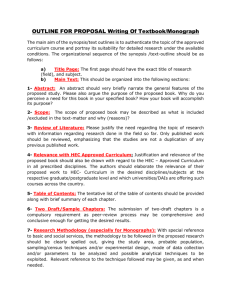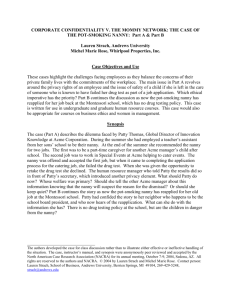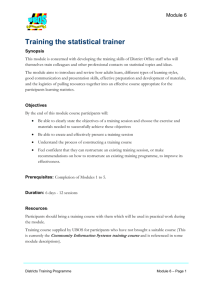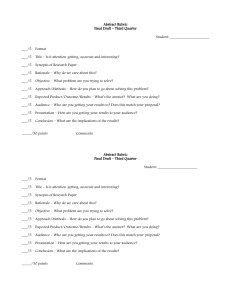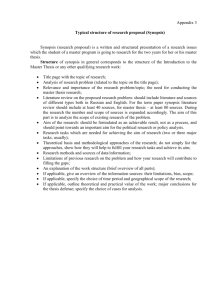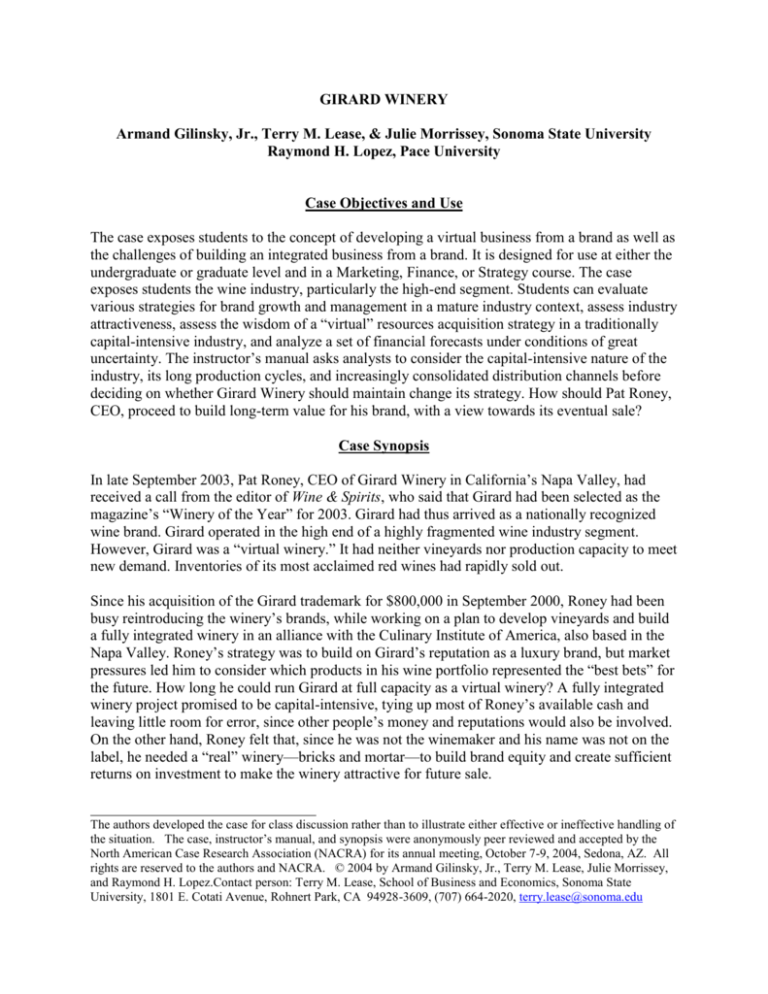
GIRARD WINERY
Armand Gilinsky, Jr., Terry M. Lease, & Julie Morrissey, Sonoma State University
Raymond H. Lopez, Pace University
Case Objectives and Use
The case exposes students to the concept of developing a virtual business from a brand as well as
the challenges of building an integrated business from a brand. It is designed for use at either the
undergraduate or graduate level and in a Marketing, Finance, or Strategy course. The case
exposes students the wine industry, particularly the high-end segment. Students can evaluate
various strategies for brand growth and management in a mature industry context, assess industry
attractiveness, assess the wisdom of a “virtual” resources acquisition strategy in a traditionally
capital-intensive industry, and analyze a set of financial forecasts under conditions of great
uncertainty. The instructor’s manual asks analysts to consider the capital-intensive nature of the
industry, its long production cycles, and increasingly consolidated distribution channels before
deciding on whether Girard Winery should maintain change its strategy. How should Pat Roney,
CEO, proceed to build long-term value for his brand, with a view towards its eventual sale?
Case Synopsis
In late September 2003, Pat Roney, CEO of Girard Winery in California’s Napa Valley, had
received a call from the editor of Wine & Spirits, who said that Girard had been selected as the
magazine’s “Winery of the Year” for 2003. Girard had thus arrived as a nationally recognized
wine brand. Girard operated in the high end of a highly fragmented wine industry segment.
However, Girard was a “virtual winery.” It had neither vineyards nor production capacity to meet
new demand. Inventories of its most acclaimed red wines had rapidly sold out.
Since his acquisition of the Girard trademark for $800,000 in September 2000, Roney had been
busy reintroducing the winery’s brands, while working on a plan to develop vineyards and build
a fully integrated winery in an alliance with the Culinary Institute of America, also based in the
Napa Valley. Roney’s strategy was to build on Girard’s reputation as a luxury brand, but market
pressures led him to consider which products in his wine portfolio represented the “best bets” for
the future. How long he could run Girard at full capacity as a virtual winery? A fully integrated
winery project promised to be capital-intensive, tying up most of Roney’s available cash and
leaving little room for error, since other people’s money and reputations would also be involved.
On the other hand, Roney felt that, since he was not the winemaker and his name was not on the
label, he needed a “real” winery—bricks and mortar—to build brand equity and create sufficient
returns on investment to make the winery attractive for future sale.
The authors developed the case for class discussion rather than to illustrate either effective or ineffective handling of
the situation. The case, instructor’s manual, and synopsis were anonymously peer reviewed and accepted by the
North American Case Research Association (NACRA) for its annual meeting, October 7-9, 2004, Sedona, AZ. All
rights are reserved to the authors and NACRA. © 2004 by Armand Gilinsky, Jr., Terry M. Lease, Julie Morrissey,
and Raymond H. Lopez.Contact person: Terry M. Lease, School of Business and Economics, Sonoma State
University, 1801 E. Cotati Avenue, Rohnert Park, CA 94928-3609, (707) 664-2020, terry.lease@sonoma.edu
HIGH TECH BURRITO
Armand Gilinsky, Diana Clark, & T. K. Clark, Sonoma State University
Randall Harris, California State University, Stanislaus
Case Objectives and Use
The case is intended to put students in the CEO’s chair with Greg Maples as he examines a
number of strategic options to grow his business: franchising, licensing, seeking external
investors through venture capital or an initial public offering, or seeking the outright sale of HTB
to a larger restaurant chain. Through analysis of the company (SWOT, Porter’s 5-Forces,
financial ratios) the students are then taken through a discussion of the strategic alternatives
facing HTB, including the possibility of franchising. The case also provides fertile ground for the
discussion of a number of operational issues, including HR practices, staffing a service-based
business, marketing, promotion and financial planning.
Case Synopsis
The High Tech Burrito (HTB) case is the study of Greg Maple’s restaurant business that started
as a small well-located Burrito shop. From these humble beginnings, HTB had grown to be a
sixteen-store enterprise in the San Francisco Bay Area. HTB had capitalized on the beginning of
the “fast-casual” trend in the restaurant industry. In May 2003, Greg was considering several
options for his business.
Not everything had gone right for founder Greg Maples. His mother had died young, providing
Greg with the small inheritance that got him started. He opened his first HTB store in 1986 in
San Rafael, CA. His second store was opened in 1989 in Novato, CA. Growth was slow at first,
and resulted in HTB squandering its early mover advantage. After several years, Greg had the
opportunity to take on an investor, which he did. This case studies some of the advantages and
consequences of investor financing. By the time the dust had settled, Greg was floundering in
partnership issues, copycat competitors, co-branding opportunities, growth problems, and HR
issues. The case examines HTB’s philosophy, their team, and their operational problems.
Finally, the case discusses the strategic alternatives available to Greg Maples as he attempted to
position HTB for future growth and success.
The authors developed the case for class discussion rather than to illustrate either effective or ineffective handling of
the situation. The case, instructor’s manual, and synopsis were anonymously peer reviewed and accepted by the
North American Case Research Association (NACRA) for its annual meeting, October 7-9, 2004, Sedona, AZ. All
rights are reserved to the authors and NACRA. © 2004 by Armand Gilinsky, Diana Clark, T.K. Clark, and Randall
Harris. Contact Person: Randall Harris, CSU, Stanislaus, 801 W. Monte Vista Avenue, Turlock, CA, 95382, 209667-3723, raharris@csustan.edu
JETBLUE AIRWAYS, 2004
Brian Shutt & Mary Kay Sullivan (faculty supervisor)
Maryville College
Case Objectives and Use
This case looks at a company very successfully employing a “low-cost” strategy. It allows
exploration of how competitive advantage emanates from a set of interrelated activities.
JetBlue’s value-creating activities promote the objectives of both low cost and customer service,
making it very difficult for a competitor to replicate such a re-inforcing fit. The question here is
this: How can JetBlue continue its success in the face of pending major changes in the industry.
The case was written for undergraduate courses in strategic management.
Case Synopsis
JetBlue Airways Corporation offered low-fare, low-cost passenger air transportation on primarily
point-to-point routes. It began service in February, 2000, out of New York’s John F. Kennedy
Airport. JetBlue’s founder was David Neeleman, who had previously been involved in two other
aviation start-ups. At the heart of the company’s success was its focus on the customer. The
“JetBlue Experience” involved leather seats, a TV set at every seat, and friendly service.
The company kept costs low through high levels of productivity. Aircraft utilization was the
highest in the industry. Crewmembers were incentivized to be productive and distribution costs
were low. With a new fleet of Airbus 320s, JetBlue saved training and maintenance costs.
At the end of fiscal 2003, JetBlue Airways was flying high. It was one of only two profitable
airlines in an industry plagued by high costs and the increased hassle of flying after the terrorist
attacks of September 11, 2001. JetBlue’s operating margins in 2003 were 16.9%; the cost per
available seat mile of 6.08 cents was well below the industry average. Market value added was
substantial: $100 invested in JetBlue at the initial public offering in 2002 would have been worth
$221 in December, 2003.
But there were signs that the airline industry was on the cusp of change. Fractional ownership of
small jets was increasing and new programs offered a certain number of hours of flight on a
private jet at a fixed cost. In addition, the idea of “air taxi” service, using new “very light jets”
was poised to become a reality. These changes could possibly upset JetBlue’s competitive
advantage. Analysts were beginning to question the future of JetBlue. Would the airline’s
strategy be sufficient for the coming decade?
The authors developed the case for class discussion rather than to illustrate either effective or ineffective handling of
the situation. The case, instructor’s manual, and synopsis were anonymously peer reviewed and accepted by the
North American Case Research Association (NACRA) for its annual meeting, October 7-9, 2004, Sedona, AZ. All
rights are reserved to the authors and NACRA. © 2004 by Brian Shutt and Mary Kay Sullivan. Contact person:
Mary Kay Sullivan, Maryville College, Maryville TN 37804-5907, 865-981-8234,
marykay.sullivan@maryvillecollege.edu
KODAK AT A CROSSROAD:
THE TRANSITION FROM FILM-BASED TO DIGITAL PHOTOGRAPHY
Boris Morozov & Rebecca J. Morris (faculty supervisor)
University of Nebraska at Omaha
Case Objectives and Use
After reading and studying this case, students should be able to (1) understand the forces of
change that were reshaping the business environment for firms in the photography industry in the
twenty-first century; (2) understand the risks involved in developing corporate level strategy
when the cash cow business is in a declining market; and (3) Understand the risks involved in
competing in a market against newer and more nimble competitors. This case was developed for
use in undergraduate and MBA level courses in strategic management. The case is designed to
be positioned in the course during discussions of corporate level strategies. The case could also
be used to illustrate a rapidly changing industry environment and the pressures the changes cause
for traditional firms in the industry. The case may also be appropriate for undergraduate and
graduate courses in marketing strategy.
Case Synopsis
In 2003, Eastman Kodak Company faced one of the biggest challenges in its long history: what
should the company do now that demand for its traditional film products was rapidly declining.
Should the company turn its back on traditional photography (about 70% of company revenues)
to embrace new digital photography technologies? Was this strategy too risky for the company
given that the digital photography arena was highly competitive and that many competitors had a
head start on developing a coherent digital strategy. Should Kodak, a company whose name was
synonymous with film and photographic papers, really exit a market so central to its identity?
Stockholders and stock analysts were questioning whether Kodak was moving rapidly enough
into the digital photography market. As the price for digital cameras and photo printers declined,
consumers were embracing the new technologies much quicker than Kodak executives had
expected. Although international photography markets held out some promise for growth in
traditional photography, Kodak knew it was only a matter of time before the whole world “went
digital.” They also knew that the decisions they made in 2003 were “make or break” decisions—
Kodak was indeed at a crossroads and they held the future of this great company squarely in their
hands.
The authors developed the case for class discussion rather than to illustrate either effective or ineffective handling of
the situation. The case, instructor’s manual, and synopsis were anonymously peer reviewed and accepted by the
North American Case Research Association (NACRA) for its annual meeting, October 7-9, 2004, Sedona, AZ. All
rights are reserved to the authors and NACRA. © 2004 by Boris Morozov and Rebecca Morris. Contact person:
6001 Dodge Street, Roskens Hall 508K, Omaha, NE 68182, 402-554-3542, Rmorris@unomaha.edu.
KRCB TELEVISION AND RADIO: THE CANARY IN THE COAL MINE?
Teresa Marie Shern, Armand Gilinsky (faculty supervisor), & Robert Girling
(faculty supervisor), Sonoma State University
Case Objectives and Use
This case was written to illustrate the challenges of management within nonprofit organizations.
While the primary objectives and methods of operation differ between nonprofit and for-profit
organizations, executives of nonprofit organizations should use a strategic approach to managing
and positioning their organizations. The CEO has been with KRCB since its inception and faces
the challenges of crafting strategy, setting the tone at the top, and preserving an entrepreneurial
corporate culture. The main objectives are to: illustrate why organizations need to continuously
update their mission/vision to guide future policy decisions; heighten student understanding of
social entrepreneurship; give students practice assessing internal and external environments in a
nonprofit context; give students an opportunity to develop a strategic plan for an organization
amidst great uncertainty in its internal and external environments; and stimulate discussion about
the role of the strategic leader in setting the tone at the top.
This case is suitable for undergraduate and graduate level courses in Strategic Management,
Nonprofit Management, Entrepreneurship, Social Entrepreneurship, and Leadership. It should be
taught at the end of undergraduate or graduate level courses and is also suitable as a final exam.
Case Synopsis
In October 2003, Nancy Dobbs, President and CEO of Rural California Broadcasting
Corporation, and her Board of Directors were faced with the reality that though they had
continually run the station on a thin financial margin, things were not improving. KRCB-FM’s
latest pledge drive had significantly missed its goal, as had pledge drives at other National Public
Radio (NPR) stations around the San Francisco Bay Area. KRCB was faced with numerous
challenges. These included: intense regional competition, industry consolidation, increased
operating costs, technology changes (digital conversion), a declining number of volunteers,
changes in the composition of its Board of Directors, a plateau in memberships, and a loss of
underwriting from local businesses. What KRCB needed was a way to work beyond these issues,
moving past the first 20 years of operation and forward into the next 20 years. The question
remained as to whether or not the current leadership at KRCB was capable of developing
strategies, marshalling resources to carry-out those strategies, and following-through with the
necessary implementation.
The authors developed the case for class discussion rather than to illustrate either effective or ineffective handling of
the situation. The case, instructor’s manual, and synopsis were anonymously peer reviewed and accepted by the
North American Case Research Association (NACRA) for its annual meeting, October 7-9, 2004, Sedona, AZ. All
rights are reserved to the authors and NACRA. © 2004 by Teresa Shern, Armand Gilinsky, and Robert Girling.
Contact person: Teresa Shern, School of Business & Economics, Sonoma State University – Rohnert Park, 1801 E.
Cotati Avenue, Rohnert Park, CA 94928, 707-765-6941, teresa_shern@yahoo.com
LIBERTY MOVING AND STORAGE
Stuart Rosenberg, Dowling College
Case Objectives and Use
This case demonstrates the importance of having a succession plan strategy in a family-owned
business. The process of passing control of a business can be more problematic when family
members are involved. Family businesses might not undertake the level of planning for
succession that other types of organizations would. This lack of strategy can cause serious
implications for the business, including uncertainty and frustration among family members,
which could affect ongoing profitability.
The teaching note was written for undergraduate or graduate courses in Strategic Management.
Because many of the problems related to the human side of succession planning are even more
acute in this case, it can also be used in courses in Organizational Behavior.
Case Synopsis
Mike Federico, the president and chief executive officer of Liberty Moving and Storage Co.,
Inc., had run the family business for several years and was approaching retirement. His two
sons, Mike Jr. and Anthony, were in their thirties and both had been in the business since the
1990s, but no formal plan for succession existed. In early 2003, Liberty Moving and Storage
received a critique of its operations and management structure from the American Moving and
Storage Association. The report cited a number of operating issues within the business that
required improvement. The central finding in the report was that the leadership of Liberty
Moving and Storage was poor and that it threatened the growth and profitability of the company.
Mike and his wife, Cindy, had started thinking about passing the business on to Mike Jr., who
had assumed increased responsibilities at Liberty Moving and Storage in recent years. However,
the report pointed out that Mike Jr. had no college education and lacked the necessary skills to
take over the business. The report presented three options in connection with the senior
management structure of the company. The first option would be to bring in an outsider to report
to Mike as an executive vice president while grooming Mike Jr. The second option would be to
promote Mike Jr. to president now and to hire a business coach to help with his personal
development. The third option would be to continue the organization as it was currently
structured. Mike and Cindy were uncertain as to which was the right approach for Liberty
Moving and Storage, illustrating the fact that a strategic business plan, including a plan for
succession, might have helped to avoid the situation that they presently found themselves in.
The author developed the case for class discussion rather than to illustrate either effective or ineffective handling of
the situation. The case, instructor’s manual, and synopsis were anonymously peer reviewed and accepted by the
North American Case Research Association (NACRA) for its annual meeting, October 7-9, 2004, Sedona, AZ. All
rights are reserved to the author and NACRA. © 2004 by Stuart Rosenberg. Contact person: Stuart Rosenberg,
School of Business, Dowling College, Idle Hour Boulevard, Oakdale, NY 11769-1999, 631-244-3423,
rosenbes@dowling.edu
MEDIMMUNE, INC.: MANAGING GLOBAL SUPPLY CHAINS
Douglas N. Ross & Sharma Pillutla, Towson University
Christopher Hodge, MedImmune, Inc
Case Objectives and Use
This case shows how a growing biotechnology company must come to grips with changes in
focus and direction. It is suitable for use in strategic management, small business/
entrepreneurship and supply chain management courses. It has been used in an undergraduate
business policy and strategy course and makes a nice case for student presentations. It can be
used effectively midway into a strategy course which demonstrates the link between strategy
development and strategy implementation. It can be used in supply chain management courses to
demonstrate the strategic elements of supply chain design and the need for such a design process
to be rooted in a broader strategic approach. The case could be used to emphasize the importance
of government regulation in a Business and Society course. Teaching objectives include: expose
students to the challenges faced by a growing biopharmaceutical company as it adapts its supply
chain to new demands; expose students to the critical aspects of dealing with a federal regulatory
regime; understand the relevance of competitive analyses and evaluate whether MedImmune can
meet its financial challenges.
Case Synopsis
The case presents the opportunity to look at an important new industry, a player of growing
capability in the marketplace, and assess the hurdles of multiple supply chains that confront
companies in this phase of development. Further, the case sets out the “symbiotic” relationship
between biotech companies and regulators. Due to the $1.6 billion acquisition of Aviron (and
with it FluMist), MedImmune reported a $1.1 billion loss in 2002 but MedImmune has a $250+
million positive cash flow. In 2001 sales were $619 million, while in 2002 sales rose to $848
million, a 37% increase. Results from 2003 are expected to top $1 billion. In fifteen years,
MedImmune has become one of the leading firms in its product development of monoclonal
antibodies (MAb). Antibodies are produced by the body’s immune system as a response to an
“invading” substance such as pollen grains. Their flagship product, launched in 1998, is Synagis,
which currently accounts for over 80% of revenues. Synagis tackles the leading cause of
premature infant’s hospitalization due to bronchitis and bronchiolitis. MedImmune’ s original
R&D focus has morphed into “Operational Excellence” involving the design of global supply
chains for both mature and developing products. Whether firm strategy, and its supporting
structure, can re-focus to capture market share is an open question.
The authors developed the case for class discussion rather than to illustrate either effective or
ineffective handling of the situation.
The authors developed the case for class discussion rather than to illustrate either effective or ineffective handling of
the situation. The case, instructor’s manual, and synopsis were anonymously peer reviewed and accepted by the
North American Case Research Association (NACRA) for its annual meeting, October 7-9, 2004, Sedona, AZ. All
rights are reserved to the authors and NACRA. ©2004 Douglas N. Ross, Sharma Pillutla and Christopher Hodge.
Contact person: Douglas N. Ross, Towson University, 8000 York Road, Towson, MD 21252, 410-704-4071,
dross@towson.edu
MOUNT VINTAGE PLANTATION GOLF CLUB
Peter Basciano, Don Howard, & Nabil Ibrahim
Augusta State University
Case Objectives and Use
The case shows how three entrepreneurs initiated a potentially profitable but risky golf
community development. The project is experiencing growing pains and has not completely met
the investors’ expectations. They are facing several critical issues in the management, marketing
and financial areas. The case was written for business school graduate and undergraduate courses
in business strategy, entrepreneurship/small business, and/or marketing strategy.
Case Synopsis
Mount Vintage Plantation Golf Club, located in southern Edgefield County of South Carolina, is
a world class golf club that opened in March, 2000. It began with the desire of Bettis Rainsford,
a local businessman and history enthusiast, to develop the land that was formerly known as
Mount Vintage Plantation. In the early 1990's, he and his partner, Talmadge Knight, purchased
the fourth-thousand-acre former plantation. They were joined by Price Howard in 1998 who
served as President and CEO until recently.
The initial plan was to develop Mount Vintage Plantation as an equestrian community. After
discovering that there was limited demand for such a club in the area, the two partners
considered the development of a golf community. A feasibility study was undertaken to
determine whether there was sufficient demand for another golf course in the area and, if so,
whether the Edgefield County location they had chosen was suitable. Despite indications that the
market could not support another golf club, the owners proceeded to develop Mount Vintage
Plantation Golf Club. The Club is in its fourth year of operation and has enjoyed great initial
success. It began with a successful public offering which netted 150 member subscribers. The
Club achieved positive cash flows in its first three years.
Recently, Price Howard, who served as the first Club President, retired. Club Manager, Brian
Thelan, has been appointed interim Club President. Also, during the first few months of the year
the Club operation has failed to meet its financial plan and the owners and Advisory Board
members have expressed some concern. Thelan is in line for promotion to Club President but
feels the owners are watching carefully to see how he deals with the challenges at hand. Thelan
is faced with several important decisions as he plans the upcoming Advisory Board meeting.
The authors developed the case for class discussion rather than to illustrate either effective or ineffective handling of
the situation. The case, instructor’s manual, and synopsis were anonymously peer reviewed and accepted by the
North American Case Research Association (NACRA) for its annual meeting, October 7-9, 2004, Sedona, AZ. All
rights are reserved to the authors and NACRA. © 2004 by Peter Basciano, Don Howard and Nabil Ibrahim. Contact
person: Peter Basciano, College of Business Administration, Augusta State University, 2500 Walton Way, Augusta,
GA 30904-2200, 706-667-4535, pbasciano@aug.edu
PFSWEB AT THE STRATEGIC TIPPING POINT: GROW, MERGE, OR DOWNSIZE
Neil Jacobs, Kathryn S. Savage, & Christopher M. Scherpereel
Northern Arizona University
Case Objectives and Use
This case is appropriate for senior-level strategy or policy courses, or senior-level human
resource management courses. The case could also be used in MBA level course. Topics in the
case include assessment of business strategy, evaluation of alternatives for cash strapped,
underperforming business, and downsizing considerations from a human resources perspective.
A complete case analysis should accomplish the following teaching objectives: quantitative and
qualitative analysis of a firm’s business model; identification of the stakeholder impacts of
restructuring; human resource issues in the restructuring of an organization.
Case Synopsis
Mark Layton, CEO of PFSweb, faced some difficult decisions. PFSweb provided a full slate of
distribution services to clients who wished to outsource all or part of their distribution function.
Despite strong capabilities and technical infrastructure, and an increasing trend for businesses to
outsource non-core functions, PFSweb was operating under capacity. The firm had experienced
difficulty attracting new clients and closing deals, in part due to post 911 cautiousness, the
dotcom bust, and a recessionary economy. The firm was also reacting to an IPO separation
from Daisytek, the firm’s former parent and largest client. Investor and client confidence in
PFSweb was declining, and the cash drain from operations was a concern for management.
Steps had been taken, particularly in the sales and marketing functions, to generate additional
revenue from existing and new clients. While progress had been made, generation of new
business was slowed by a lengthy sales cycle. Additionally, excess operational costs were
draining cash reserves. Under Mark’s direction the management team was exploring several
alternatives to improve the financial health of PFSweb. The team had identified three
alternatives: PFSweb could continue their growth strategy and count on significant revenue
increases; PFSweb could find a partner for merger and take advantage of the synergies available
through the merger; or PFSweb could take immediate steps to downsize, forgoing immediate
growth and becoming a leaner, organization. Mark Layton was troubled about the impact these
alternatives would have on PFSweb’s stakeholders, especially the employees. PFSweb was at
the tipping point and a quick decision was required.
The authors developed the case for class discussion rather than to illustrate either effective or ineffective handling of
the situation. The case, instructor’s manual, and synopsis were anonymously peer reviewed and accepted by the
North American Case Research Association (NACRA) for its annual meeting, October 7-9, 2004, Sedona, AZ. All
rights are reserved to the authors and NACRA. © 2004 by Neil Jacobs, Kathryn S. Savage & Christopher M.
Scherpereel. Contact person: Neil Jacobs, College of Business Administration, Northern Arizona University, PO
Box 15066, Flagstaff, AZ 86011-5066, (928) 523-7382, Neil.Jacobs@nau.edu
PHOENIX ORGANIC
Eva Collins & Stephen Bowden, University of Waikato
Kate Kearins, Auckland University of Technology
Case Objectives and Use
The case shows the evolution of a niche natural and organic beverages manufacturer in New
Zealand. The founders of Phoenix had committed to operating the company in a sustainable way
with respect to the triple bottom lines of economic, social and environmental objectives. In
looking forward the founders were searching for growth. Most of the success of the company
had been based on a single channel – New Zealand cafes – where Phoenix had almost maximised
their penetration by May 2004. Therefore, growth required change in products, channels or
geographic markets. The case is designed to explore the tensions that exist between growth and
sustainability on a number of levels. Environmentally, the growth of Phoenix raises challenges
in terms of organic supplies as well as the footprint of the company through issues such as the
use of fossil fuels in transportation. Competitively, the growth of Phoenix raises the likelihood
of a response from much larger competitors such as Coca-Cola. The case was originally written
for an undergraduate strategy case competition and is designed for use in undergraduate and
MBA courses in strategy, entrepreneurship and/or business, government and society.
Case Synopsis
In 1987, Chris Morrison and his partner Deborah Cairns started making a naturally fermented
ginger beer in their apartment. They hand-washed old bottles and hand-filled them with the
ginger beer. By May 2004, Phoenix Organic had grown to become New Zealand’s leading
manufacturer of premium certified organic and natural beverages. And they had done all of this
while living up to their vision of making a business that was good for the planet and good for the
health of its people.
Yet despite a growth rate of 25% over the last three years, sales were still only NZ$6.5 million –
this was still very much a small business. Despite carving out a strong niche in the New Zealand
non-alcoholic beverage industry Chris, Deborah and co-founder Roger Morris were all unified in
their enthusiasm for growth. The question was how – through new products such as the Chai
they had launched, through new channels such as supermarkets, through new markets such as
Australia or Malaysia, or through some combination. Whatever option they chose it needed to
not only be good for Phoenix, but good for the planet as well.
The authors developed the case for class discussion rather than to illustrate either effective or ineffective handling of
the situation. The case, instructor’s manual, and synopsis were anonymously peer reviewed and accepted by the
North American Case Research Association (NACRA) for its annual meeting, October 7-9, 2004, Sedona, AZ. All
rights are reserved to the authors and NACRA. © 2004 by Eva Collins, Stephen Bowden and Kate Kearins.
Contact person: Stephen Bowden, Department of Strategic Management & Leadership, University of Waikato,
Private Bag 3105, Hamilton, New Zealand, 64-7-838-4472, sbowden@waikato.ac.nz
PORT OF TAURANGA LIMITED
Stephen Bowden, University of Waikato
Case Objectives and Use
The case shows the evolution and operation of the Port of Tauranga Ltd (PTL). As well as being
New Zealand’s leading port, Tauranga has demonstrated exceptional efficiency in international
benchmarking. Part of the explanation for that lies in the way that PTL manages the network of
relationships needed to operate the port – successfully engendering both co-operation and
competition. As well as being an exemplar in its efficiency and customer service, PTL is also
committed to the sustainability focus and the triple bottom lines of economic, social and
environmental objectives. Under uncertain demand conditions, PTL must seek out growth
options which do not compromise its principles. The case provides for the analysis of the
competitive advantages that are engendered by PTL relative to other ports as well as the
competitive context that PTL operates in. The case was originally written for an undergraduate
strategy case competition and is designed for use in undergraduate and MBA courses in strategy,
international business and/or business, government and society.
Case Synopsis
Jon Mayson, Chief Executive of the Port of Tauranga Limited, looked out his office window
across the pristine harbour on a beautiful spring day in October 2003. To the south the port itself
was a hive of activity with ships being loaded and unloaded on both the Mt Maunganui and
Tauranga sides of the operation. The efficiency of those activities had seen the Port of Tauranga
achieve considerable success under Mayson’s leadership – including being named the top port in
the most recent international benchmarking survey. To the north Jon looked out towards the
harbour entrance and the natural beauty that first drew him to Tauranga many years ago.
Maintaining the harmony between economic, social and environmental concerns was critical to
the sustainability business model that Jon believed in. But the challenges ahead would not be
easy. As the largest export port in New Zealand, the Port of Tauranga was very vulnerable to the
current downturn for exporters – particularly the forestry industry. The increased diversity of
cargo that Tauranga handled and the multi-port strategy adopted over recent years certainly
helped, but where to now?
The author developed the case for class discussion rather than to illustrate either effective or ineffective handling of
the situation. The case, instructor’s manual, and synopsis were anonymously peer reviewed and accepted by the
North American Case Research Association (NACRA) for its annual meeting, October 7-9, 2004, Sedona, AZ. All
rights are reserved to the authors and NACRA. © 2004 by Stephen Bowden. Contact person: Stephen Bowden,
Department of Strategic Management & Leadership, University of Waikato, Private Bag 3105, Hamilton, New
Zealand, 64-7-838-4472, sbowden@waikato.ac.nz
STRATEGY MEETS “SECURITY”
IN THE PORT OF BALTIMORE
Douglas N. Ross & Douglas M. Sanford, Jr.
Towson University
Case Objectives and Use
The Port of Baltimore case provides an introduction to the use of stakeholder management and
the creation and implementation of strategy in a complex organization. Security is a new
strategic imperative in the post-9/11 business environment that requires new technology and
human resources practices. While the traditional challenge of making positive long-term profits
does not necessarily apply, students will learn how the Port of Baltimore (POB) competes with
other ports on the eastern seaboard. Students will learn how the POB can deal with the Maryland
State appropriation process to obtain investment capital. Students will also investigate how POB
deals with other challenges including negotiating with powerful unions and updating technology.
Case Synopsis
The Port of Baltimore administration, within its political context, must balance many stakeholder
interests to carry out its mission. At the same time it must compete as a business. Management
faces economic, social and political challenges simultaneously. The case provides information on
the strategic management challenges facing the Port of Baltimore (POB). Of primary importance
is the challenge of ensuring security both of port facilities and ensuring that prohibited materials
do not enter the USA. POB competes with other Eastern seaboard ports, and the case discusses
the nature of various ports’ competitive advantages. Revenues and costs are separated, and profit
maximization in the traditional sense is not the primary strategic objective. The case alludes to
the different, political, “currency” that POB generates. Other management challenges described
in the case are dealing with powerful unions and updating technology.
The authors developed the case for class discussion rather than to illustrate either effective or ineffective handling of
the situation. The case, instructor’s manual, and synopsis were anonymously peer reviewed and accepted by the
North American Case Research Association (NACRA) for its annual meeting, October 7-9, 2004, Sedona, AZ. All
rights are reserved to the authors and NACRA. ©2004 Douglas N. Ross and Douglas M. Sanford, Jr. Contact
person: Douglas N. Ross, Towson University, 8000 York Road, Towson, MD 21252, 410-704-4071,
dross@towson.edu
UPPER MOHAWK VALLEY REGIONAL WATER BOARD
Sanjay Varshney & Edward Petronio
State University of New York Institute of Technology
Case Objectives and Use
This case gives students practice in identifying a nonprofits strategy, determining how well it is
doing, and sizing up whether it is capable of sustaining itself in today’s marketplace. It has
students do a serious assessment of a company's financial performance, the business model, and
its potential for competitive success against well established water companies. Also, the case has
students make future estimates of profitability and viability in order to determine the water
board’s options (Sell out, expand into other local regions, lower the cost of the existing
participants thru effective marketing campaign).
Case Synopsis
The village of Utica formed a water company in the beginning of the 18th century. During the
next 200 years, the Utica Water Works Association acquired lands, reservoir sites, and reparation
rights. In 1938 the city of Utica purchased in whole and by the end of the 20th century the city
was in a financial mess. They faced a number of impending fines by the federal government for
failure to comply with orders to bring the water company up to minimum federal standards.
During this time pressure by leaders in the city, county, state and federal government forced the
city to sell out to a new ownership structure which is presently known as the Upper Mohawk
Valley Regional Water Board (UMVRWB).
The current board faces a number of challenges at the present time. The infrastructure is old and
needs upgrades, government regulation is costly and increasing, safety and security problems are
heavy burden, the area is economically depressed which leads to underutilization of the
distribution system. The board is at a crossroad and needs to decide what to do. The board has
available a number of strategic options. They could sell out, expand customer base, expand
geographically, or maintain their current strategy.
The authors developed the case for class discussion rather than to illustrate either effective or ineffective handling of
the situation. The case, instructor’s manual, and synopsis were anonymously peer reviewed and accepted by the
North American Case Research Association (NACRA) for its annual meeting, October 7-9, 2004, Sedona, AZ. All
rights are reserved to the authors and NACRA. © 2004 by Sanjay Varshney and Edward Petronio. Contact person:
Edward Petronio, School of Management, SUNY Institute of Technology, P.O. Box 3050, Utica, NY 13504, (315)
635-7516, feap@sunyit.edu
THE US CATTLE INDUSTRY – DEVELOPING A FREE TRADE STRATEGY
Patricia Holman & Tom Hinthorne
Montana State University-Billings
Case Objectives and Use
The objectives are to enable students to: (1) Evaluate the forces shaping the evolution of an
industry. (2) Understand the complexities of trade negotiations and evaluate the stakeholders,
including: (a) their strengths and weaknesses, objectives and strategies, and measures of success
and (b) the likelihood their strategies may produce unanticipated outcomes sufficient to require
strategic adjustments by other stakeholders. (3) Analyze the effects of working to reduce tariffs,
export subsidies, domestic subsidies and tariff rate quotas. (4) Develop and articulate industry
scenarios and their use in the strategic planning process. The case writers developed the case for
graduate courses in business strategy, international business, and agribusiness.
Case Synopsis
In June 2004, twenty-five members of the Ranchers-Cattlemen’s Legal Action Fund United
Stockgrowers of America (R-CALF) had gathered in Billings, Montana, to discuss R-CALF’s
strategy for dealing with the highly distorted global market in which US cattle producers had to
compete. R-CALF represented the US cattle producers in trade and marketing issues. It had
more than 10,000 members in 46 states and over 60 affiliated local and state cattle and farm
organizations. Its legal counsel, Terry Stewart, international trade lawyer and managing partner
of Stewart and Stewart, led the discussion. Terry’s firm had offices in Washington D.C.,
Belgium, Russia, and the Ukraine. Leo McDonnell, Jr., rancher, co-founder and President of RCALF had invited you, an outside consultant, to attend the discussion. At the end of the day, you
met with Leo and several other R-CALF members; and Leo said:
I’m looking for someone to make a 30-minute presentation at R-CALF’s annual
convention in January 2005 in Denver. If you decide to take this job, here’s what
I’d like you to do: (1) talk about the primary forces shaping the live cattle
industry, in particular, the global forces our members are less familiar with, (2)
project the most likely industry scenarios, and (3) give us a cohesive strategy the
industry will support. Think about it and let me know. We appreciated your input
today.
The case sketches the forces shaping the evolution of the US live cattle industry, including the
recent World Trade Organization negotiations and the US Trade Representative’s negotiation of
free trade agreements (e.g., with Australia) and a Free Trade Agreement of the Americas.
The authors developed the case for class discussion rather than to illustrate either effective or ineffective handling of
the situation. The case, instructor’s manual, and synopsis were anonymously peer reviewed and accepted by the
North American Case Research Association (NACRA) for its annual meeting, October 7-9, 2004, Sedona, AZ. All
rights are reserved to the authors and NACRA. © 2004 by Patricia Holman and Tom Hinthorne. Contact person:
Patricia Holman, College of Business, Montana State University-Billings, 1500 University Drive, Billings, MT
59101-0298, 406-657-2035, pholman@msubillings.edu
WHERE’S THE SYNERGY?:
THE ACQUISITION OF SWITCHBOARD, INC. BY INFOSPACE, INC.
Raymond M. Kinnunen & Joseph W. Chevarley, Jr.
Northeastern University
Case Objectives and Use
This is a case based on two companies which were survivors of the dotcom era – Switchboard,
Inc. and Infospace, Inc. The case presents industry data, the history and strategy of the two
companies, and company statements by the Presidents of the two companies regarding their
views on the outcome of their merger. The case is ideal for analyzing the strategy behind the
combination and projecting the results in terms of market positioning and financial performance.
The case is appropriate for strategic management courses when focusing on the entrepreneurship
and innovation and technology modules.
Case Synopsis
Switchboard was the first to create a nationwide directory of white pages and yellow pages
online in 1994. Its easy-to-use web site – www.switchboard.com – offered a broad range of
functions, content and services, including yellow pages, white pages, and product searching
capability, detailed and accurate maps with complete driving directions, complete marketing and
internet services as well as an innovative tool for online promotions. The company’s stock
reached a high of $32 after its IPO which took place in March 2000, but like other internet
companies Switchboard saw its stock price crash. Switchboard was profitable in 2003, with net
earnings of $2.1 million, or $.10 per share, on revenues of $15.2 million.
Infospace was one of Switchboard’s most significant competitors. The two companies shared a
similar path, focusing on paid searches, directory services, and experienced the same financial
turmoil during the “DotCom Bust”. In January 2004, Infospace said it expected annual income
for 2004 of $21-26 million and revenues of $195-205 million. In 2003 the company had a loss
of $6.3 million, or -$0.20 per share on revenue of 160.1 million.
On Friday March 2, 2004, Infospace announced that it would acquire Switchboard for $7.75 a
share or approximately $160 million in total, which represented a 28% premium over the closing
price of $6.05 on the previous day.
The authors developed the case for class discussion rather than to illustrate either effective or ineffective handling of
the situation The case, instructor’s manual, and synopsis were anonymously peer reviewed and accepted by the
North American Case Research Association (NACRA) for its annual meeting, October 7-9, 2004, Sedona, AZ. All
rights are reserved to the authors and NACRA. © 2004 by Raymond M. Kinnunen and Joseph W. Chevarley, Jr.
Contact person: Raymond M. Kinnunen, Northeastern University, Boston, MA 02115, 617-373-4736,
r.kinnunen@neu.edu



